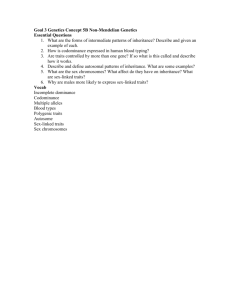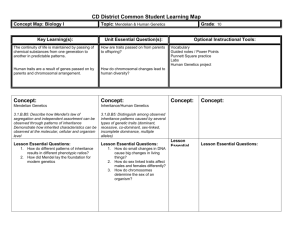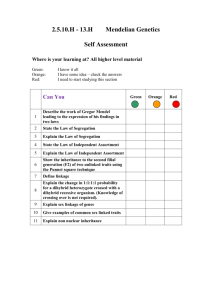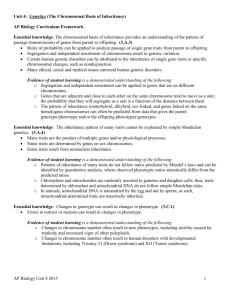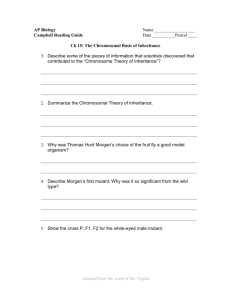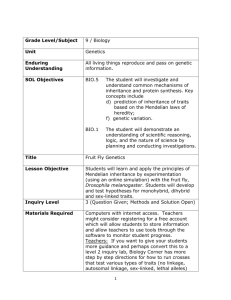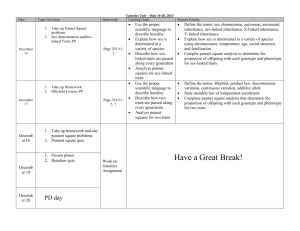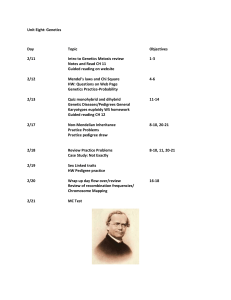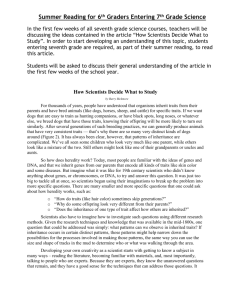Reading Guide - Belle Vernon Area School District
advertisement
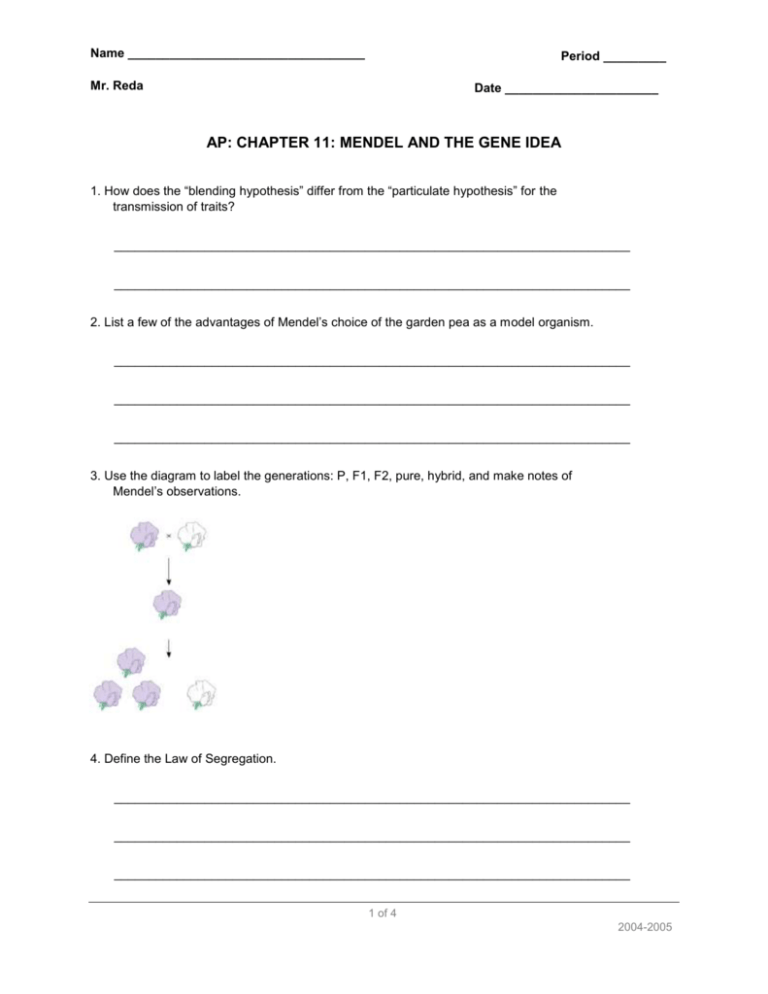
Name __________________________________ Period _________ Mr. Reda Date ______________________ AP: CHAPTER 11: MENDEL AND THE GENE IDEA 1. How does the “blending hypothesis” differ from the “particulate hypothesis” for the transmission of traits? __________________________________________________________________________ __________________________________________________________________________ 2. List a few of the advantages of Mendel’s choice of the garden pea as a model organism. __________________________________________________________________________ __________________________________________________________________________ __________________________________________________________________________ 3. Use the diagram to label the generations: P, F1, F2, pure, hybrid, and make notes of Mendel’s observations. 4. Define the Law of Segregation. __________________________________________________________________________ __________________________________________________________________________ __________________________________________________________________________ 1 of 4 2004-2005 5. Using the diagram in Question 3, describe how the Law of Segregation applies to the F1 and to the F2 generations. __________________________________________________________________________ __________________________________________________________________________ 6. When does the segregation of alleles occur? _____________________________________ 7. What is the difference between an allele and a gene? a. allele __________________________________________________________________ __________________________________________________________________________ b. gene __________________________________________________________________ __________________________________________________________________________ 8. Briefly define the following terms: a. homozygous ____________________________________________________________ b. heterozygous ___________________________________________________________ c. phenotype ______________________________________________________________ d. genotype _______________________________________________________________ 9. What is the purpose of a test cross? ____________________________________________ __________________________________________________________________________ __________________________________________________________________________ 10. When two traits are on different (non-homologous) chromosomes, how are they inherited? __________________________________________________________________________ __________________________________________________________________________ 2 of 4 2004-2005 a. Indicate the phenotypic ratios that result in the F2 from the F1 cross (dihybrid cross) 11. Use the rules of probability to determine the expected ratio of offspring showing two recessive traits in the trihybrid cross (PpYyRr X Ppyyrr). 12. Describe and give an example of incomplete dominance. ___________________________ __________________________________________________________________________ __________________________________________________________________________ 13. How does codominance compare to incomplete dominance? ________________________ __________________________________________________________________________ __________________________________________________________________________ 14. How is blood type an example of multiple alleles? _________________________________ __________________________________________________________________________ __________________________________________________________________________ 3 of 4 2004-2005 15. Define and give an example of pleiotropy. _______________________________________ __________________________________________________________________________ 16. Define and give an example of epistasis. ________________________________________ __________________________________________________________________________ 17. What is observed when traits are polygenic? _____________________________________ __________________________________________________________________________ 18. The expression of phenotypes is often a result of both… ____________________________ __________________________________________________________________________ 19. Briefly describe each of the following genetic disorders: a. Cystic fibrosis ___________________________________________________________ __________________________________________________________________________ c. Sickle cell anemia _______________________________________________________ __________________________________________________________________________ d. Achondroplasia (color blind)____________________________________________________ __________________________________________________________________________ e. Huntington’s disease _____________________________________________________ __________________________________________________________________________ 20. How can a parent learn the risks of having a child with a genetic disorder? __________________________________________________________________________ 21. After Morgan and fellow scientists developed the Chromosomal Theory of Inheritance, the search was on for the chemical mechanism of inheritance. What are the two components of the chromosome? 1. Describe some of the pieces of information that scientists discovered that contributed to the “Chromosome Theory of Inheritance”? __________________________________________________________________________ __________________________________________________________________________ 2. Summarize the Chromosomal Theory of Inheritance. __________________________________________________________________________ __________________________________________________________________________ 3. Why was Thomas Hunt Morgan’s choice of the fruit fly a good model organism? __________________________________________________________________________ __________________________________________________________________________ 4. Describe Morgan’s first mutant. Why was it so significant from the wild type? __________________________________________________________________________ __________________________________________________________________________ 5. Show the cross P, F1, F2 for the white-eyed male mutant. 6. What happens when we trace the inheritance of traits found on the same chromosome? __________________________________________________________________________ __________________________________________________________________________ 7. Use the diagram to trace the body color and wing shape in this linked two trait cross. 8. What is recombination and when does it occur? ___________________________________ __________________________________________________________________________ __________________________________________________________________________ 9. How is recombination frequency calculated? _____________________________________ __________________________________________________________________________ __________________________________________________________________________ 10. What determines sex in humans? ______________________________________________ __________________________________________________________________________ 2 of 4 2004-2005 11. In what ways are sex-linked traits distinct from autosomal traits? _____________________ __________________________________________________________________________ __________________________________________________________________________ __________________________________________________________________________ 12. Why are sex-linked recessive traits more common in human males than females? __________________________________________________________________________ __________________________________________________________________________ 4 of 4 2004-2005

